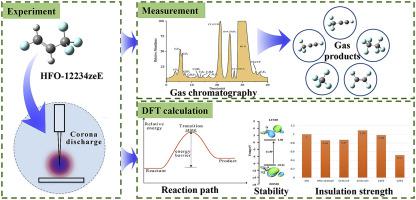Journal of Molecular Graphics and Modelling ( IF 2.9 ) Pub Date : 2020-07-08 , DOI: 10.1016/j.jmgm.2020.107671 Jingrui Wang 1 , Qingmin Li 1 , Heng Liu 1 , Xuwei Huang 1 , Jian Wang 1

|
Decomposition experiments under corona discharge and theoretical calculations using the density functional theory (DFT) method were accomplished to clarify the dissociation behavior and decomposition mechanism of HFO1234zeE (trans-1,3,3,3-tetrafluoropropene), an eco-efficient SF6 alternative gas. The discharge decomposition products of HFO are mainly fluorocarbon, unsaturated hydrocarbon and saturated hydrocarbons, which are containing no more than three carbons. Free radicals, CF3·, F· and H·, generated via bond-cleavage reaction are important structures to promote the decomposition, and HFO is more likely to dissociate with them by abstraction reaction to form CF4 and CF3H. Long-chain radicals, such as CF3CH CF·, CF3CH
CF·, CF3CH CH· and CF3C
CH· and CF3C CHF·, will be decomposed into CF3CCH and CF3CCF, and small intermediates would be easier to combine to form HF, C2F6, C2F4, C2HF5, CF3HCF3H and C3F8. It is also likely to be converted to Z-isomer. Due to the high discharge intensity and ion bombardment, solid by-products appeared on the electrode surface may contain carbon dust and metal compounds. The solid attached to the surface has little effect on the electric field distribution, and most gas decomposition products still maintain the insulation strength, so the air-gap breakdown voltage only dropped by about 6.2% after long-term corona discharge. The obtained results not only reveal the decomposition mechanism in a comprehensive way, but also present useful reference for exploring the application potentials of HFO1234zeE.
CHF·, will be decomposed into CF3CCH and CF3CCF, and small intermediates would be easier to combine to form HF, C2F6, C2F4, C2HF5, CF3HCF3H and C3F8. It is also likely to be converted to Z-isomer. Due to the high discharge intensity and ion bombardment, solid by-products appeared on the electrode surface may contain carbon dust and metal compounds. The solid attached to the surface has little effect on the electric field distribution, and most gas decomposition products still maintain the insulation strength, so the air-gap breakdown voltage only dropped by about 6.2% after long-term corona discharge. The obtained results not only reveal the decomposition mechanism in a comprehensive way, but also present useful reference for exploring the application potentials of HFO1234zeE.
中文翻译:

环保型绝缘气体HFO1234zeE分解机理的理论和实验研究。
完成了电晕放电下的分解实验以及使用密度泛函理论(DFT)方法进行的理论计算,以阐明生态高效的SF 6替代品HFO1234zeE(反式1,3,3,3-四氟丙烯)的离解行为和分解机理。加油站。HFO的放电分解产物主要是碳氟化合物,不饱和烃和饱和烃,其碳含量不超过三个。自由基,CF 3 ·,F·和H·,经由键断裂反应生成的是促进分解的重要结构,和HFO更可能通过抽象反应与它们离解以形成CF 4和CF 3 H.庆龙链自由基,例如CF 3CH  CF·,CF 3 CH
CF·,CF 3 CH  CH·和CF 3 C
CH·和CF 3 C  CHF·将分解为CF 3 CCH和CF 3 CCF,小的中间体更易于结合形成HF,C 2 F 6,C 2 F 4, C 2 HF 5,CF 3 HCF 3 H和C 3 F 8。它还可能会转化为Z-异构体。由于高放电强度和离子轰击,出现在电极表面的固体副产物可能含有碳尘和金属化合物。附着在表面的固体对电场分布的影响很小,大多数气体分解产物仍保持绝缘强度,因此在长期电晕放电后,气隙击穿电压仅下降了约6.2%。所得结果不仅全面揭示了其分解机理,而且为探索HFO1234zeE的应用潜力提供了有益的参考。
CHF·将分解为CF 3 CCH和CF 3 CCF,小的中间体更易于结合形成HF,C 2 F 6,C 2 F 4, C 2 HF 5,CF 3 HCF 3 H和C 3 F 8。它还可能会转化为Z-异构体。由于高放电强度和离子轰击,出现在电极表面的固体副产物可能含有碳尘和金属化合物。附着在表面的固体对电场分布的影响很小,大多数气体分解产物仍保持绝缘强度,因此在长期电晕放电后,气隙击穿电压仅下降了约6.2%。所得结果不仅全面揭示了其分解机理,而且为探索HFO1234zeE的应用潜力提供了有益的参考。


























 京公网安备 11010802027423号
京公网安备 11010802027423号